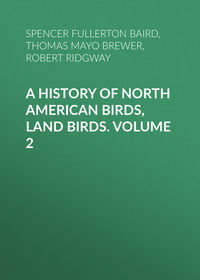 полная версия
полная версияA History of North American Birds, Land Birds. Volume 1
Pyranga rubriceps, Gray, Gen. B. fol. p. 364, pl. lxxxix, 1849.
102
Pyranga erythrocephala, Bonap. R. Z. 1851, 178. (Spermagra erythrocephala, Swains. Phil. Mag. 1827, 437.) Were it not for the small size, one would, without seeing a specimen, be inclined to suspect this as being a young male of P. æstiva, which often occurs in very similar plumage.
103
? Pyranga azaræ, D’Orb. Voy. p. 264. Ridgway, Pr. Ac. N. S. Philad. June, 1869, p. 132, fig. 2.
104
Pyranga saira, Sclater, P. Z. S. 1856, 124. Ridgway, Pr. A. N. S. June, 1869, p. 131, fig. 1. (Tanagra saira, Spix, Av. Bras. II, 48, fig. 1.)
105
Pyranga testacea, Sclater & Salvin, P. Z. S. 1868, 388. Ridgway, Pr. A. N. S. June, 1869, p. 133, f. 1.
106
Pyranga roseigularis, Cabot. (Description from the type.)
107
Of this highly colored form, the average length of five specimens is 7.55; in twelve the average is, wing, 3.67; tail, 2.86; culmen, .67. The bill appears to be slightly darker than in North American examples.
108
Coccothraustes abeillii, Sclater, Catal. Am. B. 123 (Guiraca abeillii, Lesson).
109
Carpodacus frontalis, var. hæmorrhous, Carpodacus hæmorrhous, Sclater, P. Z. S. 1856, 304. (Fringilla hæmorrhous, Licht. Verz. 1831.)
110
Loxia curvirostra, Linn., Syst. Nat. 299.
111
Loxia bifasciata, De Selys-Longchamps, Faune Beige, 76. Bonap. & Schlegel, Mon. des Loxiens, 7.
112
Fringilla linaria, Temm. Mass. Orn. 1835, 267 (not of Linnæus). “Fringilla rufescens, Vieill. Faun. Franç. tab. 41, f. 1.” Linota montium, Bp. & Schlegel, Mon. Lox. 1850. “Linaria flavirostris, Brehm.”
113
Leucosticte brunneinucha. Fringilla (Linaria) brunneinucha, Brandt, Bull. Acad. St. Petersburg, 1841, 35. Montifringilla (Leucosticte) brunneinucha, Bon. & Schlegel, Mon. Loxiens, 1850, 36, pl. xlii.
114
As this sheet is going through the press, we have been permitted by Mr. J. A. Allen to examine a series of birds, obtained by him in July, 1871, on Mt. Lincoln, Colorado, above the timber line, where they were breeding abundantly. Although very different from winter L. tephrocotis, they yet strongly suggest the idea of their being that species in summer dress. They present the following characteristics:—
Breeding plumage. Differing from the stage first described above, in entire absence of any ash about the head, and in deep black, instead of yellowish bill. ♂ with the red tints intense carmine, instead of peach-blossom pink, that of the abdomen extending farther forward. ♀ lacking the red, or with only a tinge of it. Hood dark vandyke-brown, becoming nearly black on the forehead; rest of head light chocolate-brown, similar to, but more faded than, that of the winter plumage; nasal tufts grayish-white.
Ten specimens collected by Mr. Allen all agree in the characters pointed out, by which they differ from the winter plumage of L. tephrocotis. Taking into consideration the fact of their black instead of yellowish bill, more intense red, and generally more dusky colors, as well as the other points of distinction from the previously known plumages of L. tephrocotis, and also that they are identical in size and proportion, while specimens of L. tephrocotis in the breeding plumage have not before been seen, it seems very reasonable to suppose that these specimens represent the breeding plumage of that species. There is some resemblance to L. brunneinucha, which, from the plate in Bonaparte and Schlegel’s monograph of the Coccothraustinæ, seems to differ mainly in being lighter colored. Mr. Allen says that these birds were breeding abundantly in the locality where they were found.
115
From the fact that this form is not found in any part of Alaska, nor, indeed, north of California, it is probable that the localities of anthinus and alaudinus were transposed in Bonaparte’s original descriptions.
116
Hybrid between oregonus and caniceps, = “annectens,” Baird, Geol. Surv. Cal. Orn. I, p. 564.
Char. Pinkish sides and convex outline to ash of breast, as in oregonus, with the bright rufous back and ashy head, with black lores of caniceps; a tendency in the rufous of back to tinge the wings, as in oregonus. Hab. Southern Rocky Mountains. (Fort Whipple, Arizona, Coues; Fort Bridger, Wyoming, Drexler; Fort Burgwyn, Mountains of Colorado, Aiken.)
117
Hybrid between hyemalis and oregonus.
Char. Plumbeous back of hyemalis, with pinkish sides of oregonus; or else reddish back of oregonus and plumbeous sides of hyemalis, or colors mixed both above and below. Hab. Sun River, Dakota; McKenzie River District? Fort Whipple, Arizona; and Fort Bridger, Wyoming.
118
Hybrid between caniceps and cinereus, = “dorsalis,” Henry, Pr. Phil. Ac. 1858, 117; Baird, Birds N. Am. 1858, 467.
Char. Rufous restricted to interscapular region, as in the former, with black upper mandible, and pale ash throat of the latter. Hab. Fort Thorn, New Mexico.
119
Junco cinereus, Cabanis, Mexican Snowbird. Fringilla cinerea, Sw. Syn. Birds Mex. in Phil. Mag. I, 1827, 435. Junco cinereus, Cabanis, Mus. Hein. 1850, 134.—Baird, Birds N. Am. 1858, 465. “Fringilla rufidorsis, Licht.,” Bonaparte; probably a catalogue name. Junco phæonotus, Wagler, Isis, 1831, 526.—Bonap. Comptes Rendus, XXXVII, 518.
Sp. Char. Ash-color above; with a broad quadrate interscapular patch of rufous-chestnut, this extending over the wing-coverts and inner secondaries. Beneath paler ash, lighter in middle region below, but without distinct line of demarcation. Lores and anterior region of eye dusky; in decided contrast. Outer three tail-feathers white, but dusky at base and on outer web at end; the amount increasing internally. Upper bill entirely black; lower yellow. Length, 6.40; height of bill, .25; culmen, .46. Hab. Table-lands of Mexico.
120
Junco alticola, Salvin, Guatemalan Snowbird. Junco alticola, Salvin, P. Z. S. 1863, 189 (Highlands, Guatemala).—Ib.. Ibis, 1866, 193.
Sp. Char. Similar to J. cinereus, but darker than Mexican species, with less contrast between the rufous of back and the ash of head. Tail with less white. Bill much larger: height, .34; culmen, .56. Hab. Highlands of Guatemala.





